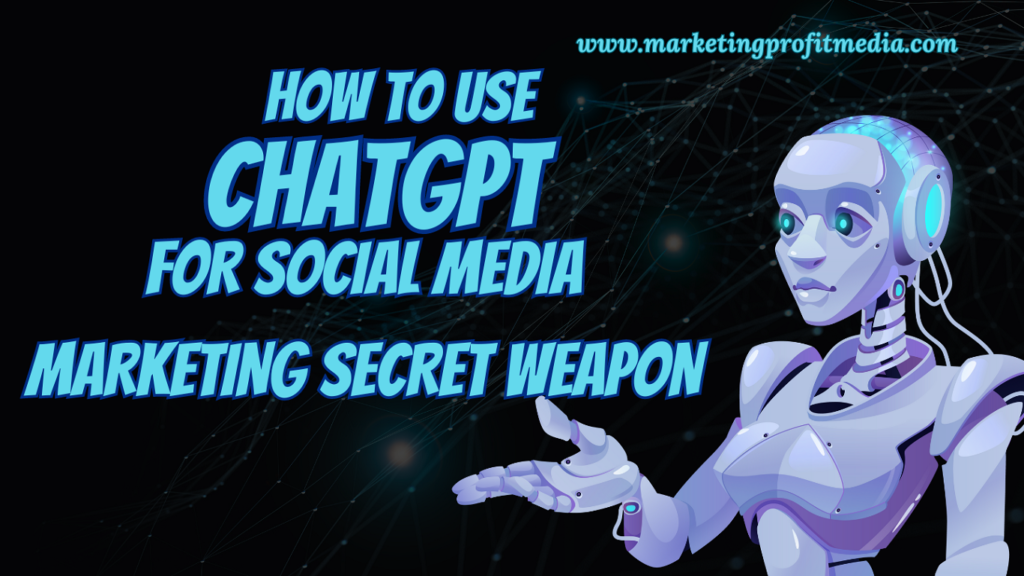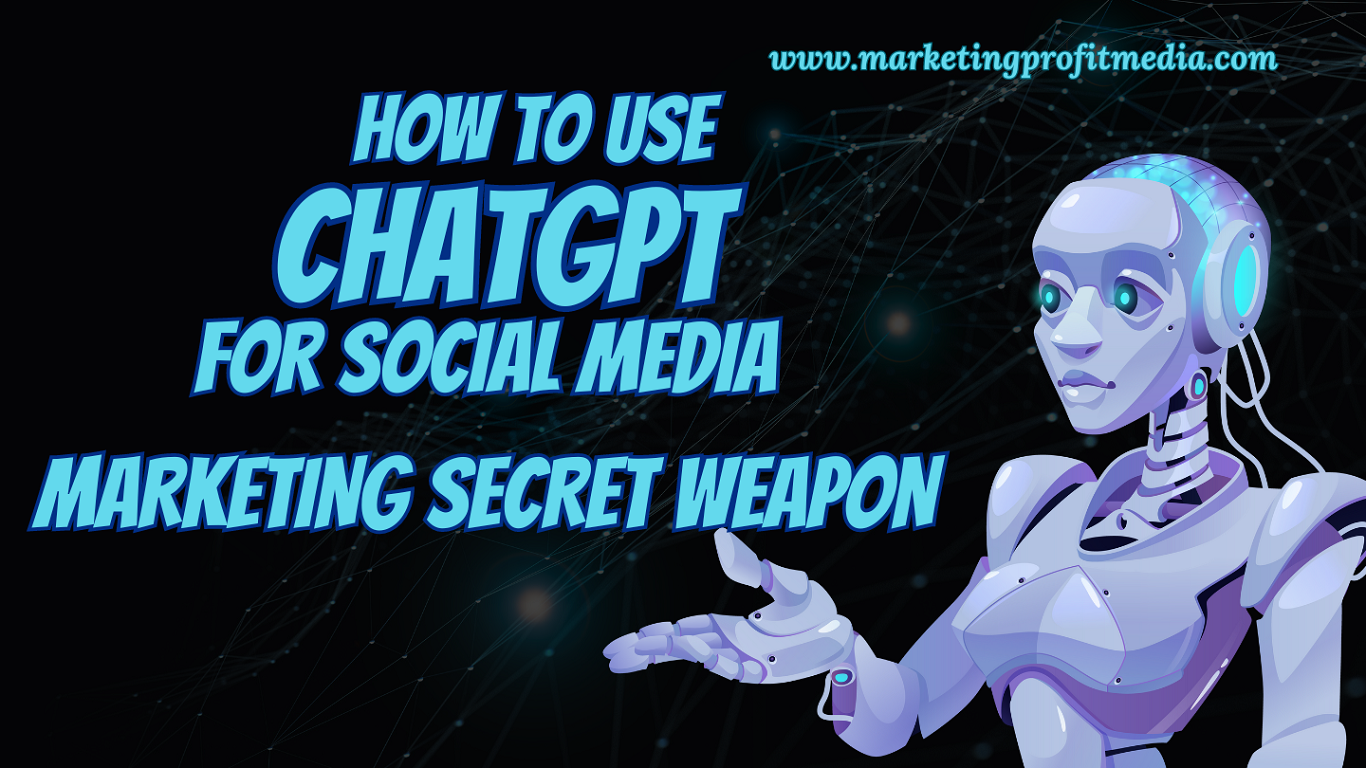Welcome to the world of ChatGPT, where cutting-edge AI meets social media marketing. In this digital era, mastering the art of online engagement is essential. ChatGPT is your secret weapon, offering insights into how to harness its capabilities to supercharge your social media marketing efforts. In this comprehensive guide, we’ll delve into the intricacies of leveraging ChatGPT’s power to create compelling content, enhance customer interactions, and unlock data-driven success. Get ready to transform your social media strategy and stay ahead of the competition with ChatGPT as your trusted ally.
My Best Recommended & Proven Way to Make $100 Daily – Watch THIS FREE Training to START >>

What is ChatGPT?
OpenAI’s ChatGPT is a cutting-edge artificial intelligence language model. When it comes to processing natural language, it is clearly a game-changer. ChatGPT’s primary goal is to mimic human conversation via text, making it a helpful tool for many fields, including social media marketing. ChatGPT’s unique selling point is that it can have conversations with its users, responding to their questions and supplying them with information while also seeming to mimic human communication. In order to provide coherent and contextually appropriate replies, it uses deep learning algorithms and a large dataset to understand context.
ChatGPT provides a wealth of opportunities for social media marketers. Posts, captions, and even whole articles may be generated with its help. Optimising advertising campaigns, analysing patterns, and gaining insights from real-time data are all within its capabilities. It’s a flexible tool that can be moulded to meet the needs of any marketing initiative. ChatGPT is more than just a tool; it’s an adaptive AI-powered assistant that streamlines and improves the social media marketing process and facilitates better engagement with target audiences.
The ChatGPT formula
To get the most out of ChatGPT, you have to pose the write queries. Currently, the following formula is functioning well:
Write me a (text type) that is (tone and style). Emphasizing/highlighting (characteristics).
For example: “Create a persuasive, humorous, conversational Facebook advertisement that highlights the benefits and significance of a digital marketing strategy.”
Then, request that it further modify the response:
For instance: “Write a second version of this advertisement that focuses on and targets people who want to start a business.”
Examples of how social media marketers can use ChatGPT
ChatGPT is the ideal ally for social media marketing due to its extraordinary capacity to expedite content creation, boost engagement, and provide valuable insights. In contrast to conventional marketing tools, ChatGPT’s adaptability enables marketers to generate personalised and context-aware content, thereby nurturing deeper connections with their audience. In addition, it can manage large amounts of data, allowing for data-driven decision making and real-time trend analysis. In an era where authenticity and efficacy are paramount, ChatGPT arises as a secret weapon, empowering marketers to navigate the dynamic social media landscape with finesse.
1. Caption writing
Caption writing is an art that ChatGPT excels in. Crafting captivating and concise captions is crucial for social media success. ChatGPT’s versatility allows it to generate captions that resonate with audiences, whether it’s for Instagram, Twitter, or any platform. With its ability to convey messages effectively in limited characters, ChatGPT simplifies the often-challenging task of crafting engaging and memorable captions.
My Best Recommended & Proven Way to Make $100 Daily – Watch THIS FREE Training to START >>
2. Image creation
Image creation is a vital aspect of social media marketing, and ChatGPT offers a unique advantage in this area. With its text-to-image capabilities, ChatGPT can generate images that precisely match your content. It is a valuable tool for creating captivating graphics, infographics, and even custom illustrations, all of which can enhance the visual attractiveness and impact of your social media posts, allowing your brand to stand out in a congested digital landscape.
3. Social media captions
A fashion brand can use ChatGPT to generate personalised Instagram captions that describe the advantages and features of their clothing items. ChatGPT can also increase engagement by using language that resonates with the brand’s target audience.
4. Blog posts
A travel agency can use ChatGPT to create blog posts about various travel destinations, including details about local culture, activities, and lodging. ChatGPT can also employ persuasive and engaging language to convince readers to schedule a trip with the company.
5. Product descriptions
An e-commerce company can use ChatGPT to generate distinctive and engaging product descriptions for its website. ChatGPT can use its knowledge of the language and tone of its target audience to improve the persuasiveness of its descriptions and increase conversions.
6. Instagram stories
A food delivery service can use ChatGPT to create Instagram stories highlighting the various dishes they offer and the advantages of using their service. ChatGPT can also use satire or narratives to make the stories more engaging and to increase user engagement.
7. Email campaigns
A health supplement subscription service can use ChatGPT to generate personalised email campaigns that introduce new products, offer discounts and promotions, and foster customer relationships. ChatGPT can generate multiple subject lines to boost open rates and, consequently, conversions.
8. Facebook posts
A personal finance company can use ChatGPT to create Facebook posts that educate and inform their audience about budgeting, saving, and investing, among other financial topics. ChatGPT can utilise its knowledge of the language and tone of the target audience to make posts more engaging and increase user engagement.
9. Twitter threads
A news organisation can use ChatGPT to create Twitter threads that summarise complex news stories in an approachable and engaging manner. ChatGPT can also use its comprehension of the target audience’s language and tone to make threads more persuasive and increase user engagement.
10. YouTube videos
A cosmetics brand can use ChatGPT to generate scripts for YouTube videos showcasing their products, demonstrating how to use them, and providing audience members with advice. ChatGPT can also use its knowledge of the language and tone of the target audience to make the video more engaging and increase user engagement.
My Best Recommended & Proven Way to Make $100 Daily – Watch THIS FREE Training to START >>
11. Podcasts
Using ChatGPT, a health and wellness company can create podcast scripts that address a variety of health and wellness-related topics, such as nutrition, exercise, and mental health. ChatGPT can utilise its knowledge of the language and tone of the target audience to make podcasts more engaging and increase user engagement.
The key to ChatGPT is to asking the right questions to ensure you get the written content that you need. Here are some key tips on how to ask the correct questions:
- Be clear and specific: Clearly state what information or assistance you’re looking for. Vague or ambiguous questions may lead to unclear answers.
- Use complete sentences: Formulate your questions in complete sentences, as this helps provide context and ensures the model understands your query better.
- Ask one question at a time: Avoid asking multiple questions in a single query. It’s easier for the model to respond effectively when you focus on one question or topic.
- Provide context: If your question relates to a specific topic or situation, provide some background information or context. This helps the model understand the context and provide more relevant answers.
- Use open-ended questions: Instead of asking yes/no questions, use open-ended questions that encourage detailed responses. For example, ask “Can you explain…” instead of “Is it true that…”
- Specify preferences: If you have a particular preference or need, be explicit about it. For example, if you want a brief summary or a detailed explanation, state that in your question.
- Ask for sources: If you need information from credible sources, explicitly request it. For instance, you can ask, “Can you provide a reputable source that supports this?”
- Avoid jargon or abbreviations: Try to use plain language and avoid industry-specific jargon or abbreviations that the model might not understand.
- Use follow-up questions: If the initial response doesn’t fully address your query or you need more information, feel free to ask follow-up questions for clarification or elaboration.
- Be patient: Sometimes, the model may need a moment to generate a response, especially for complex or lengthy questions. Give it some time to generate a thoughtful answer.
Remember that ChatGPT’s responses are generated based on the text data it has been trained on, and it doesn’t have access to real-time information. If you’re looking for current or specific information, it’s always a good practice to verify and cross-reference the information from authoritative sources.
Conclusion
In conclusion, ChatGPT arises as a revolutionary force in social media marketing. Its versatility in content creation, including generation of captions and images, enables marketers to effectively captivate and engage audiences. Additionally, its data-driven insights facilitate informed decision-making, ensuring campaigns are optimized for success. As social media landscapes evolve, ChatGPT continues to be a secret weapon, guiding marketers towards authentic, efficient, and effective strategies that drive results and establish long-lasting connections with their target audience.
My Best Recommended & Proven Way to Make $100 Daily – Watch THIS FREE Training to START >>
Thanks for reading my article on “How to Use ChatGPT for Social Media Marketing Secret Weapon“, hope it will help!














